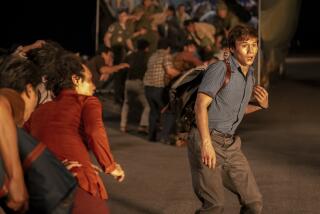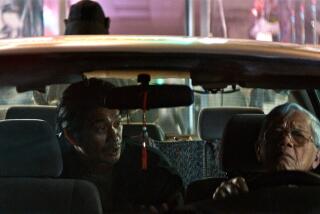Peacetime Mileage on War Route
- Share via
DAKRONG, Vietnam — The Ho Chi Minh Trail, which carried a million North Vietnamese soldiers south and confounded the United States’ top military strategists for a decade, belongs to history now, its network of hidden dirt roads reclaimed by jungle, leeches and ghosts of a war long past.
But though abandoned, there is hardly anything or anyone, save Ho Chi Minh himself, that the Vietnamese of the north hold more dear than the supply route that was once the world’s deadliest road. Without it, Hanoi’s dream of a reunified Vietnam might well have remained only a dream.
To the Americans, the trail was as much a logistical nemesis as B-52 bombers were a deadly nightmare to the North Vietnamese. Many of the war’s most famous battles--Khe Sanh, Hamburger Hill, Ia Drang--were fought, at least indirectly, for control of this meandering track that started in a gorge that Hanoi’s troops called “Heaven’s Gate.” And some of the war’s most valuable lessons were learned here, among them that air power alone doesn’t guarantee victory and that military might is sometimes no match for nationalism.
“I drove this stretch of the road many, many times during the war, hauling ammunition, supplies, taking the wounded north,” said Sgt. Trong Minh Long, 48, who carries a shovel instead of a gun these days. “There was no more dangerous duty.”
Today Long and 30 army colleagues are back on this ribbon of track now known as Highway 14, near the former U.S. encampment at Khe Sanh. Chinese- and Russian-made trucks, relics of the early war years, rumble by loaded with gravel and rock. Soldiers cluster around bamboo huts where rice and chicken broth simmer in charcoal-warmed caldrons and freshly washed fatigues are laid across bushes to dry in the breathless summer heat. The long-silent jungle stirs at last with voices and movement and the dividends of peace.
In the largest state-financed public works program since the Vietnam War ended in 1975, the trail is being reborn and rebuilt, this time as the Ho Chi Minh Highway. The new road will link Hanoi with Ho Chi Minh City, formerly Saigon, 1,050 miles to the south, and open up vast expanses of previously inaccessible terrain.
The four-year project is monumental. It will cost $400 million, a staggering sum for one of Southeast Asia’s poorest countries. More than 300 bridges will be built. Hills will be razed, tunnels burrowed. Narrow dirt roads will be widened, raised for flood control and paved. Unexploded mines and bombs will be defused.
Long’s 11th Engineer Brigade is but the vanguard of a work force that eventually will number 50,000 soldiers and youth volunteers.
“We think the highway will have a big economic impact,” Ha Dinh Can, the project’s general director, said in Hanoi, the capital. “There will be a huge boost to employment. Timber and coffee producers will have easier access to their markets. Tourists will be able to get to remote areas that were unreachable before. Driving times will be shortened.”
A Trail Entwined in War Myths, Realities
But whatever its peacetime evolution, the Ho Chi Minh Trail, commemorated in a new museum outside Hanoi, will remain entwined in the myths and realities of war--in the relentless U.S. bombing that over a decade closed the artery for only two days, in the deaths of 20,000 North Vietnamese on their journey south, in the kinship that bonded people who lived and worked on the trail, sometimes for years at a stretch, and found in their communal hardship an inexplicable romanticism and contentment.
“I loved everyone with a passionate love,” wrote Le Minh Khue, 51, a Hanoi novelist who, as a teenager, spent five years on the trail repairing bombed roads. Of her feelings for her fellow workers and the southbound boy soldiers everyone called the “Hanoi men,” she wrote that it was a love “that only someone who had stood on that hill in those moments could understand fully. That was the love of the people in smoke and fire, the people of war.”
Hanoi long maintained that the war against the Saigon regime was fought by indigenous Viet Cong guerrillas, not North Vietnamese soldiers, and that Hanoi’s direct support of the Viet Cong was in response to the landing of the first U.S. combat troops, in Danang on March 8, 1965. But the history of the trail--which is the history of the war itself--indicates that Hanoi’s battle plans were drawn a full 10 years before the arrival of the first two Marine battalions.
On May 19, 1955, Ho Chi Minh’s 65th birthday, Maj. Vo Bam, a defense supply specialist, was instructed to find a supply route south. Traveling with 500 troops, Bam put together a patchwork of paths through the triple-canopy jungle.
By the winter of 1962-63, North Vietnam had 5,000 troops and an engineering regiment assigned to the trail. Over the next few years, the route was upgraded into a network of roads that covered 10,000 miles.
“We got our orders to move south in January 1966,” recalled Nguyen Duc Bao, 70, a retired colonel who lives in Ho Chi Minh City. “The trail was very secret then. We’d lay a canvas sheet over dirt roads, and the last man across would roll it up so there’d be no footprints. We carried our own weight in weapons, supplies, medicine. We set up storehouses for rice. Usually, it was a 20-day walk from one storehouse to the next. In between, we ate roots.
“At first, the American bombing wasn’t so bad. But malaria, snakes, starvation, drowning, accidents were just as deadly. In the four months it took us to reach the south, 100 men in my regiment died. I counted 24 different ways you could die on the road.”
Hanoi claimed to have shot down 2,500 U.S. planes over the trail; the Pentagon said it lost 500 planes. But whatever the truth, Operations Steel Tiger and Tiger Hound set the forests ablaze, littered the trail with charred corpses and scorched vehicles, triggered landslides and, by CIA estimates, probably killed only one soldier for every 300 bombs dropped.
Only the Americans called the artery that passed through Laos, Vietnam and Cambodia the Ho Chi Minh Trail. To the Vietnamese, it was Truong Son Road--named after the north-south mountain range that severs Vietnam--or Highway 559, in honor of Bam’s 559th Engineer Brigade.
Using elephants, horses, specially designed bikes--which could carry 500 pounds of supplies--and, later, trucks, Hanoi’s volunteer Shock Youth Brigades Against U.S. Aggression for National Salvation--many of them women--turned Bam’s old footpath into what would become the road to victory.
“We’re in the middle of nowhere here,” said Dam Trong Nam, 26, one of the soldiers building the new highway. “But when you think what the people went through during the war on the road, you don’t complain. We’re building our country just like they did, helping develop the economy. I really hope the Americans understand how important the highway is and help us more and more to develop our economy.”
The United States dropped 1.7 million tons of bombs on the Ho Chi Minh Trail in an unsuccessful effort to cut off supplies. It used rain-inducing techniques to flood the trail and Agent Orange to strip the jungle awning. It gave antipersonnel cluster bombs their first significant test. It dropped “invisible” parachutes--sensor devices that burrowed into the ground like bamboo sprouts and relayed data back to Nakhon Phanom in Thailand for evaluation by U.S. intelligence experts. It constructed the McNamara Line, an electronic cordon with 20,000 sensors reaching from the South China Sea to the Laotian border.
But month by month, year after year, the soldiers and supplies reaching the south increased. Infiltrators set buckets of urine near chemical sensors, or drove water buffalo past motion-detecting sensors, so that transmitted data were often meaningless.
And the trail itself became an intertwined web of bypasses and parallel tracks and access roads onto which traffic could be rerouted, much like a railroad switching yard. By 1968, an estimated 150,000 North Vietnamese soldiers had safely made the journey south. By 1975, trucks were making the journey to the southern front--a trek that had taken foot soldiers six months--in 23 days.
“My unit shot down 32 U.S. planes,” said Nguyen Thanh Son, 50, a former antiaircraft gunner. “I used to think of the pilots as savages when they were in the planes. Then I saw three or four who’d been shot down, and they were like little children. They cried. They were afraid of the U.S. bombs like we were.
“Our trenches were only large enough for Vietnamese, not the Americans, who were very big. So we gave them shovels and said, ‘Dig your own trench.’ They dug very quickly. They were frightened. In short, they were human beings like us.”
Son says it’s funny but, despite the death and destruction he witnessed, he clings to memories from those years that are warm and comforting.
‘The Whole Forest Would Cry’
The best friendships he ever had were made along the road. There was beauty in the sounds of soft rain tapping on the jungle canopy and in the sight of cloud-shrouded mountains. He even remembers the names of war photographers such as Trong Thang who developed their film in glazed clay pots by candlelight and fought as infantrymen during the day.
“Our happiest times on Truong Son were when we got mail from home,” said Thang, 58, one of Vietnam’s most celebrated wartime photographers. “We’d read them aloud to each other. Pretty soon one soldier would laugh, then everyone would laugh until the forest shook with laughter. You’d feel so guilty for being happy, you’d cry, and the whole forest would cry.
“We hungered for love. I remember watching, from behind a bush, three girls take off their clothes and bathe in a stream. When they emerged, they looked like fairy princesses. They were so young, so beautiful. I wanted to take their picture, but I didn’t because they were nude, and it wouldn’t have been appropriate. An hour later, they were killed in a B-52 strike. I still ask myself, ‘Why didn’t I take their picture nude to keep their memory alive for history?’ ”
The new Ho Chi Minh Highway will link up in places with Vietnam’s only existing north-south route--Highway 1 on the eastern seaboard, a war-bloodied road the French called “Street Without Joy”--but 83% of it will follow the old trail.
The project has captured the imagination of most Vietnamese, but support for it is hardly universal.
Critics say the highway is too expensive and doesn’t serve the major population centers. Environmentalists complain that it will cut through ecologically sensitive areas, including Vietnam’s first national park in the north, and will disrupt the lives of ethnic minority tribes. Many foreign investors contend that it would be wiser to widen and improve the existing north-south highway.
And some, like antiaircraft gunner Son, believe that the Ho Chi Minh Trail should be left untouched--a monument, however inaccessible, to a rite of passage.
“The most important memory of my life is time on Truong Son Road,” Son said. “When we vets get together, we often say: ‘We have nothing now. We are very poor. We have only the memory of Truong Son Road.’ It was a time of hardship, of sacrifice, but in a way it was also a time of happiness because we were young and still romantic then.”
More to Read
Sign up for Essential California
The most important California stories and recommendations in your inbox every morning.
You may occasionally receive promotional content from the Los Angeles Times.










